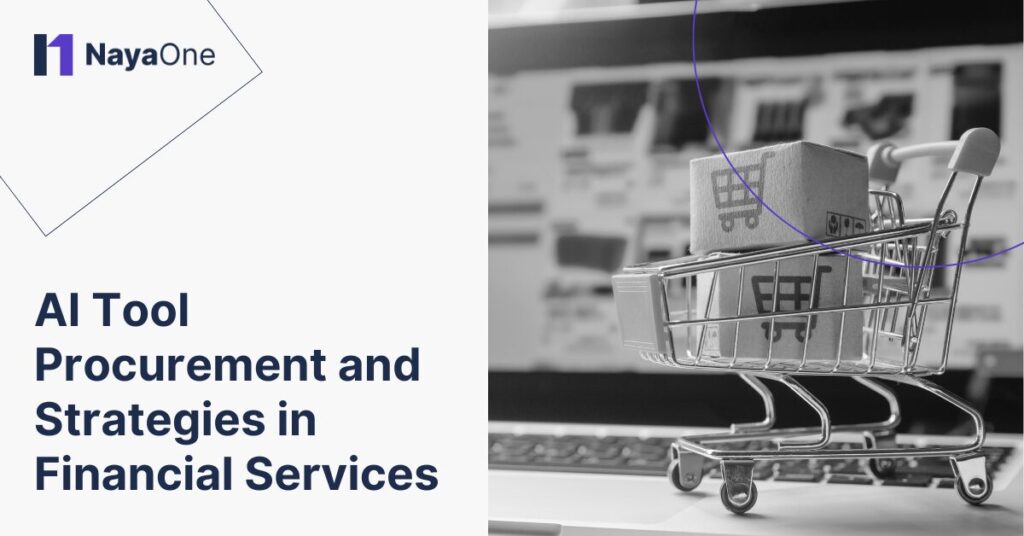
Oli Platt
Head of Client Solutions
AI in financial services is the only way forward. Finding AI tools for your financial institution can be as hard as looking for a needle in a haystack. However, identifying the tools that align with your specific needs, objectives, and capabilities are essential to unlocking the true potential of AI in financial services. Let’s delve into the complex landscape of AI tool sourcing in the financial industry and empower you to make informed decisions that drive innovation and growth.
AI Use in Financial Services: Current Trends and Use Cases
Artificial Intelligence (AI) is revolutionising the financial services industry. It’s empowering organisations to enhance operational efficiency, improve customer experiences, and drive innovation across various domains. Here are some of the current use cases of AI in financial services:
Process Automation
AI technologies automate repetitive and rule-based tasks, such as data entry, document processing, and reconciliation, across banking and financial operations. By deploying AI-powered bots, financial institutions can streamline back-office processes, reduce manual errors, and accelerate workflow efficiency.
Chatbots and Virtual Assistants
AI-driven chatbots and virtual assistants provide personalised customer support, account management, and product recommendations through natural language processing (NLP) and machine learning algorithms. They enable banks to offer round-the-clock assistance, enhance customer engagement, and improve satisfaction levels.
Fraud Detection and Risk Management
AI algorithms analyse vast amounts of transaction data, user behaviour patterns, and market trends to detect anomalies, identify potential fraud, and mitigate risks in real time. By leveraging machine learning and predictive analytics, financial institutions can enhance cybersecurity measures, combat financial crime, and safeguard against fraudulent activities.
Credit Scoring and Loan Underwriting
AI-powered credit scoring models assess creditworthiness, predict default risks, and automate loan underwriting processes based on comprehensive data analysis. AI algorithms analyse financial history, transaction patterns, and alternative data sources, enabling banks to make faster, more accurate lending decisions and offer personalised loan products to customers.
Algorithmic Trading and Portfolio Management
AI-driven algorithms analyse market data, identify trading opportunities, and optimise investment portfolios to maximise returns and minimise risks. Through quantitative analysis, machine learning, and predictive modelling, financial institutions can automate trading strategies and optimise asset allocations, achieving superior investment performance in dynamic market conditions.
Regulatory Compliance and Anti-Money Laundering (AML)
AI technologies facilitate regulatory compliance by automating compliance checks, monitoring transactions for suspicious activities, and ensuring adherence to regulatory requirements. By leveraging AI-driven analytics and pattern recognition, financial institutions can detect compliance violations and mitigate AML risks, maintaining regulatory compliance across global jurisdictions.
Personalised Wealth Management
AI-powered wealth management platforms provide personalised investment advice, financial planning, and portfolio management services tailored to individual preferences and goals. By analysing customer profiles, risk appetites, and market trends, AI algorithms enable wealth managers to deliver customised investment strategies, optimise asset allocations, and enhance client outcomes.
Predictive Analytics and Customer Insights
AI-driven predictive analytics tools analyse customer data, market trends, and economic indicators to generate actionable insights and predictive models. Financial institutions can anticipate customer needs, identify cross-selling opportunities, and personalise marketing campaigns to improve customer acquisition and retention.
AI Tool Procurement Challenges
Procuring AI tools for financial services presents a myriad of challenges that organisations must navigate to ensure successful adoption and implementation. These challenges stem from various factors, such as technological complexity, regulatory constraints, and organisational barriers. Understanding and addressing these challenges is crucial for financial institutions to leverage AI effectively and derive maximum value from their investments. Here are some key challenges:
Lack of Internal Expertise
Many financial institutions lack the necessary expertise and understanding of AI technologies to make informed procurement decisions. This lack of internal knowledge can hinder the evaluation of AI tool vendors and the identification of suitable solutions for specific use cases.
Evaluation and Selection
Evaluating and selecting AI tool vendors can be a daunting task, given the vast array of options available in the market. Financial institutions must carefully assess factors such as functionality, scalability, reliability, and vendor reputation to determine the best fit for their needs.
Data Privacy and Security
Financial institutions deal with sensitive customer data. This makes data privacy and security paramount concerns. Ensuring that AI tools comply with data protection regulations and security standards is essential to mitigate the risk of data breaches and regulatory penalties.
Budget Considerations
AI investments can be substantial, and financial institutions must justify the return on investment (ROI) to secure budgetary approvals. Demonstrating the tangible benefits and
potential cost savings of AI adoption is critical for overcoming budget constraints and securing buy-in from stakeholders.
Regulatory Compliance
The regulatory landscape governing AI in financial services is complex and constantly evolving. Financial institutions must ensure that AI tools comply with relevant regulations, such as GDPR, while also adhering to industry-specific guidelines and best practices. Emerging AI legislation like the EU AI Act is also to be taken into consideration.
Talent Acquisition
Building and maintaining AI capabilities requires a skilled workforce with expertise in data science, machine learning, and AI. However, there is a shortage of AI talent in the job market. This makes it challenging for financial institutions to recruit and retain qualified professionals.
Legacy Systems Integration
Many financial institutions work with outdated legacy systems and infrastructure that are ill-equipped to support AI initiatives. Integrating AI technologies into existing systems requires significant investment in modernisation and digital transformation efforts.
Resistance to Change
Adopting AI involves organisational change and cultural transformation. This can meet resistance from employees, stakeholders, and traditional decision-making processes. Overcoming resistance to change requires effective change management strategies and clear communication of the benefits of AI adoption.
AI Tool Sourcing: Finding the Right Fit
Sourcing the right AI tools for financial services involves a meticulous process of research, evaluation, and selection to ensure alignment with organisational objectives and requirements. Financial institutions must navigate a vast landscape of vendors, technologies, and solutions to identify the most suitable AI tools for their specific use cases. Here are key steps to effectively source AI tools:
Define Requirements and Objectives
Begin by clearly defining the objectives and requirements of the AI initiative. Identify the specific use cases and business challenges that AI tools are intended to address. This will
help narrow down the scope and focus of the sourcing process and ensure alignment with strategic goals.
Conduct Market Research
Research the market to identify potential AI tool vendors and solutions that meet the defined requirements. Consider factors such as functionality, scalability, reliability, industry expertise, and customer reviews. Leverage industry reports, analyst insights, and peer recommendations to gather comprehensive market intelligence.
Evaluate Vendor Capabilities
Assess the capabilities and track record of AI tool vendors to determine their suitability. Evaluate factors such as technology stack, domain expertise, implementation experience, customer references, and financial stability. Engage with vendors through demonstrations, workshops, and proof-of-concept projects to gain firsthand insights into their offerings.
Consider Integration and Compatibility
Ensure that AI tools are compatible with existing systems, data sources, and infrastructure within the organisation. Evaluate the ease of integration and interoperability with legacy systems to minimise disruptions and maximise operational efficiency. Consider factors such as data formats, APIs, and data governance requirements.
Assess Data Privacy and Security
Prioritise data privacy and security considerations when sourcing AI tools. Verify that vendors adhere to industry standards and regulatory requirements for data protection, encryption, access controls, and threat detection. Conduct thorough due diligence to mitigate the risk of data breaches and compliance violations.
Evaluate Total Cost of Ownership
Assess the total cost of ownership (TCO) of AI tools over their lifecycle, including upfront costs, licensing fees, implementation costs, maintenance expenses, and ongoing support. Consider factors such as scalability, flexibility, and cost-effectiveness to ensure long-term sustainability and ROI.
Engage Stakeholders
Involve key stakeholders from across the organisation in the sourcing process to gain diverse perspectives and foster buy-in. Collaborate with business units, IT departments, risk management teams, and compliance officers to ensure alignment with organisational objectives and regulatory requirements.
Negotiate Contracts and Service Level Agreements
Negotiate contracts and service level agreements (SLAs) with selected vendors to establish clear expectations, deliverables, and timelines. Define metrics for performance monitoring, service delivery, and customer support to hold vendors accountable and mitigate risks.
Pilot and Validate
Conduct pilot projects or proof-of-concept initiatives to validate the functionality and effectiveness of selected AI tools in real-world scenarios. Gather feedback from end-users, stakeholders, and subject matter experts to identify areas for improvement and refinement before full-scale deployment.
Monitor and Evaluate Performance
Continuously monitor and evaluate the performance of AI tools post-deployment to ensure they meet expectations and deliver the intended outcomes. Establish key performance indicators (KPIs) aligned with business objectives and track progress against predefined benchmarks. Iterate and refine the implementation based on feedback and insights gathered from ongoing monitoring and evaluation.
Strategies for Success
AI holds immense potential to drive growth, innovation, and competitiveness within the financial services industry. Here are key strategies for leveraging AI to harness its full benefits and maximise its impact
Define Clear Objectives and Use Cases
Begin by defining clear objectives and use cases for AI adoption aligned with your organisation’s strategic goals. Identify specific pain points, inefficiencies, or opportunities where AI technologies can deliver tangible value, whether it’s improving customer experiences, optimising operations, or enhancing risk management processes.
Build a Robust Data Foundation
Data is the lifeblood of AI, and building a robust data foundation is critical for AI success. Invest in data quality, governance, and infrastructure to ensure clean, reliable data sources that fuel AI algorithms and models. Leverage data integration, aggregation, and cleansing techniques to consolidate disparate data silos and create a unified data ecosystem for AI-driven insights.
Invest in Talent and Capabilities
Invest in training and development programmes to ensure your teams can utilise AI solutions effectively. Foster a culture of continuous learning, experimentation, and collaboration to drive innovation and stay ahead of the curve
Collaborate with Industry Partners
Collaborate with industry partners, fintech startups, and technology vendors to accelerate AI adoption and access specialised expertise, resources, and solutions. Leverage external networks, accelerators, and incubators to stay informed about emerging trends and technologies shaping the future of AI in financial services.
Prioritise Ethical AI and Responsible Innovation
Prioritise ethical AI principles, responsible innovation, and algorithmic transparency to build trust and credibility with customers, regulators, and other stakeholders. Implement robust AI governance frameworks, ethical guidelines, and compliance measures to ensure AI systems adhere to ethical standards, fairness principles, and regulatory requirements.
Measure Impact and ROI
Establish key performance indicators (KPIs) and metrics to measure the impact and return on investment (ROI) of AI initiatives. Define quantifiable goals, such as improved customer satisfaction, cost savings, revenue growth, or risk reduction, and track progress against these objectives over time. Leverage data analytics, performance monitoring tools, and predictive modelling techniques to assess AI performance, identify optimisation opportunities, and make data-driven decisions to drive business outcomes.
Accelerating AI Tool Procurement in Financial Services with NayaOne’s AI Sandbox
NayaOne’s AI Sandbox is a game-changer in AI tool procurement for financial services organisations. It provides a controlled environment where banks and financial institutions can find, compare, test, and validate AI-powered solutions without disrupting their core operations or risking regulatory compliance. Banks can build functional Proofs-of-Concept within 4-6 weeks without onboarding fintechs. As a result, they can ensure the solution is a right fit. By offering access to synthetic data, NayaOne’s AI Sandbox fosters innovation as well as ensures security and compliance. Ready to explore the possibilities of AI in your financial services organisation? Contact us today to learn more about how our AI Sandbox solutions can accelerate your innovation journey.





